Day 6 - Saturday 9/17/05
Old Eilat Neighborhood
After breakfast at the hotel, we set out on a driving tour of Eilat, primarily to view the sites of the older town where my parents and the Dekel's had lived and worked in their Eilat years. We then set out north towards the Dead Sea and Masada, with a few stops on the way.
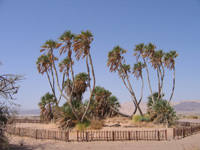
Dekel Dom
The Dekel Dom (Dom Palm) trees north of Eilat are the northernmost grouping of this particular species of palm on the globe. My parents remembered this site as one of the special things about Eilat from when they lived here years ago. Another unique feature of Eilat is that its coral reef, the northern part of the Red Sea's 4500 km of reefs, is the northernmost coral reef in the world. Another little-known fact is that Eilat is one of the best places in the world for bird watching. Its unique position as the only land bridge between Asia and Africa makes it one of the world's most important bird migratory routes. Approximately one billion birds traverse the area between the Mediterranean coast and the mountains of Jordan making southern Israel the site of one of the greatest concentrations of migrating birds in the world. The migration from Europe to Africa takes place from September to November and the return flight begins in March and lasts through May.
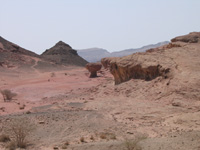
|
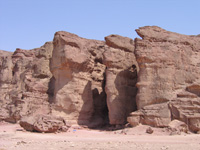
|
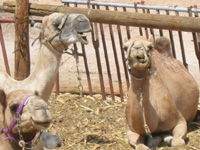
|
Copper Mines at Timna
We then traveled to Timna, site of the fabled King Solomon's Mines. In the 14th through 12th centuries BCE, the Egyptians under the Pharaohs Seti I through Ramses V established and maintained enormous copper mining operations at Timna, the worlds earliest mine. They used mules to transport the ore to the natural port at the Gulf of Eilat. In the 1st and 2nd centuries CE the Romans worked the mines, and after the Ottoman conquest the Arabs took over the site. The valley also has amazing natural red sandstone formations carved by erosion such as The Mushroom and Solomon's Pillars. There are petroglyphs carved into the rock dating back to the Egyptian occupation, and a temple to the Egyptian goddess Hathor - ruler of mines and turquoise. There is also a manmade lake where we were finally able to get close to camels.
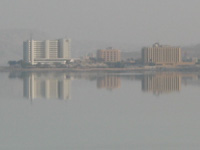
|
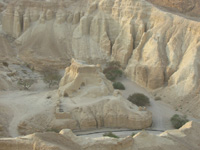
|
Dead Sea and Masada
We drove via the Dead Sea to Masada, where we were told that the site closed at 4pm - it was 4:22 at the time. No worries - this enabled us to go back to the Dead Sea and explore that landmark further. These mineral rich waters lie at the lowest point on the planet, 417 meters / 1373 feet below sea level. On our way out of the Dead Sea basin, we stopped at an overlook for a view of the Zohar Fortress, and ancient settlement on the old caravan route from the Dead Sea to Arad.
<<--- Yesterday |
Tomorrow --->> |
| Copyright © 2005 by Oreet Herbst and John Knott |